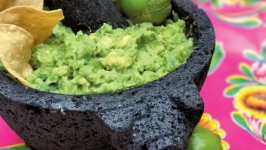What’s in Season - Tasty Tomatillos
ONCE-FOREIGN FRUIT HAS FOUND A WELCOMING HOME
Fresh tomatillos have become commonplace in our markets today, but that wasn’t always the case. The green or purple fruit with its paper-thin husk was once rarely found outside of Hispanic markets. You could find canned tomatillos in the international section of large supermarkets, but finding fresh tomatillos, which have quite a different texture and taste than canned ones, took some effort.
However, as our taste for Mexican and Southwestern food and flavors has increased—become voracious, in fact—the availability of fresh tomatillos has grown, along with our knowledge about how to use the lemony-tasting fruit to make salsas, stews and salads. They are an important ingredient in mole verde, for enchiladas suizas and for both chunky and smooth green salsas. A particular favorite dish that requires green sauce is huevos divorciados—fried eggs with beans, covered on one half with green sauce, the other half with red sauce (hence the moniker “divorced eggs.”)
I’ve grown tomatillos on and off for years, and right now I have several planted in the garden, along with my tomatoes. The plant itself resembles a tomato plant, which is not surprising since both are in the Solanancae or nightshade family, but the tomatillo plant is scrappier looking with thinner branches and wider, more ragged-edged leaves. When the fruit begins to develop, it looks like a tiny tomato encased in a large, pale green, translucent lantern. As the fruit grows it eventually fills, and often cracks open, the husk, which eventually dries.
When you find the lime-green tomatillos in the market, some of them can be quite large and they usually have some, if not all, of the dried husk still attached. Less readily found are the smaller purple tomatillos, also with their husks. Culinarily, they can be treated the same way and can be used raw or cooked.
One way to bring out extra flavor in tomatillos, and one that a Mexican friend from Guadalajara swears by, is to toast the tomatillos on a hot comal or grill before using them in salsas. I’ve made salsas both ways, toasted and raw, and I do find that a little prior toasting gives a hint of smokiness. Denise Roa, executive chef at the famed Rancho la Puerta spa in Tecate, Mexico, makes a tomatillo sauce for chard enchiladas by simply combining raw, chopped tomatillos with garlic, onion and chiles in a blender and blending until smooth. The sauce is then simmered until thickened, when a little crema or plain yogurt is added. It is excellent and ever so easy to make.
Tomatillos have now become standard fare in our supermarkets, alongside other Hispanic essentials like cilantro, jicama and fresh chilies of all kinds. This means that you can find them fairly easily year round, but late summer and fall are the season for locally grown tomatillos. This is also the season for locally grown chilies, making it high time to whip up a delicious guacamole that features both.






